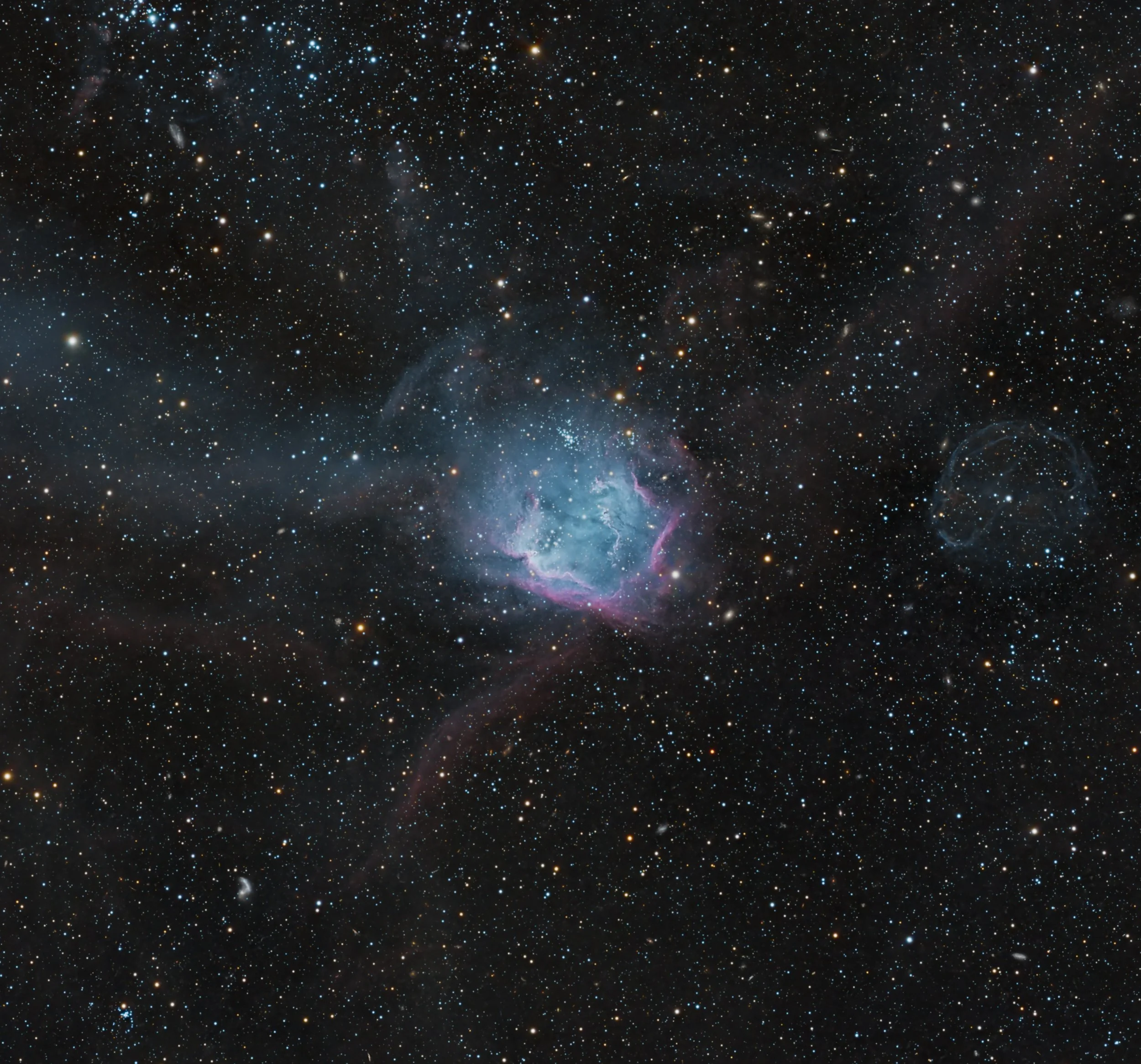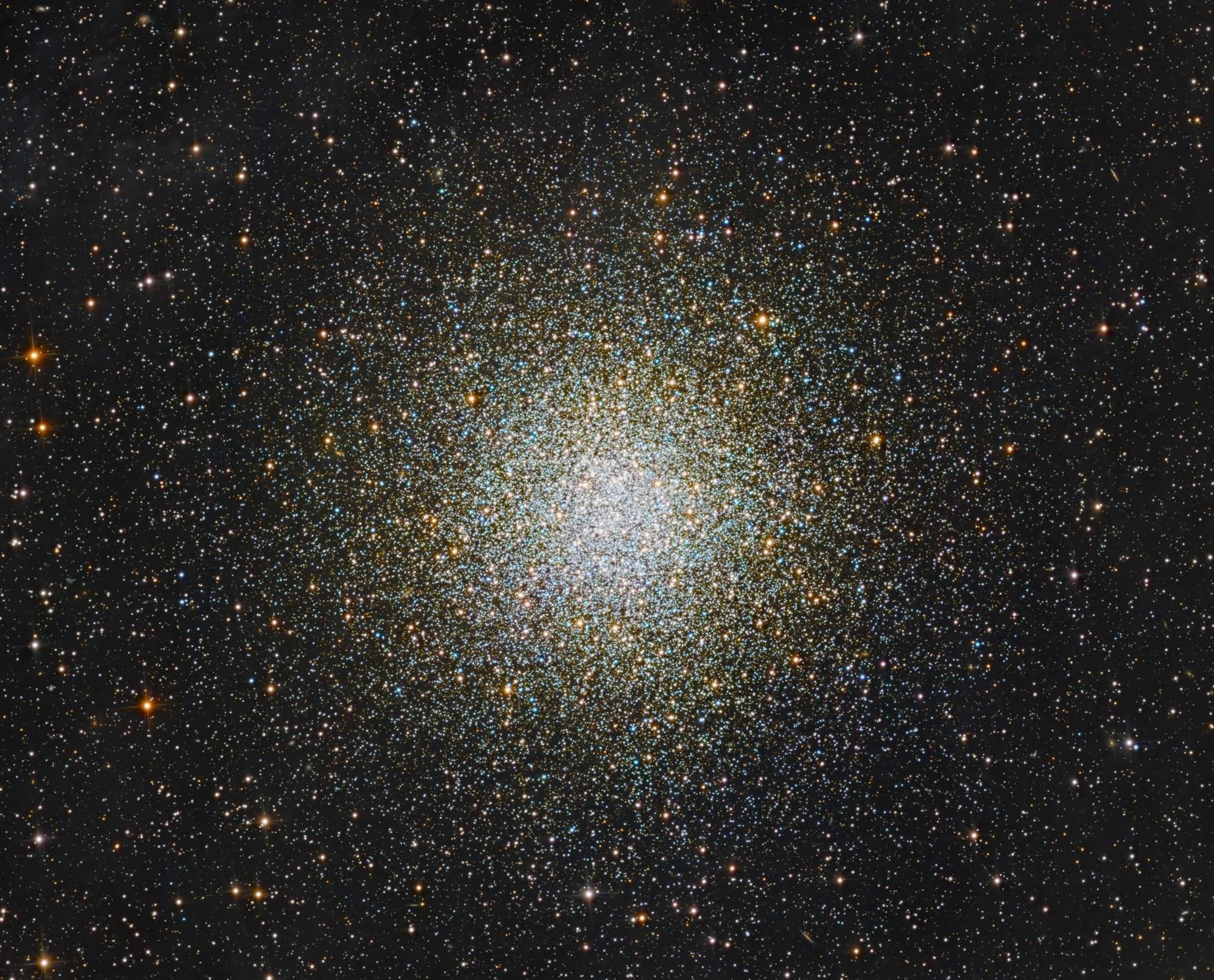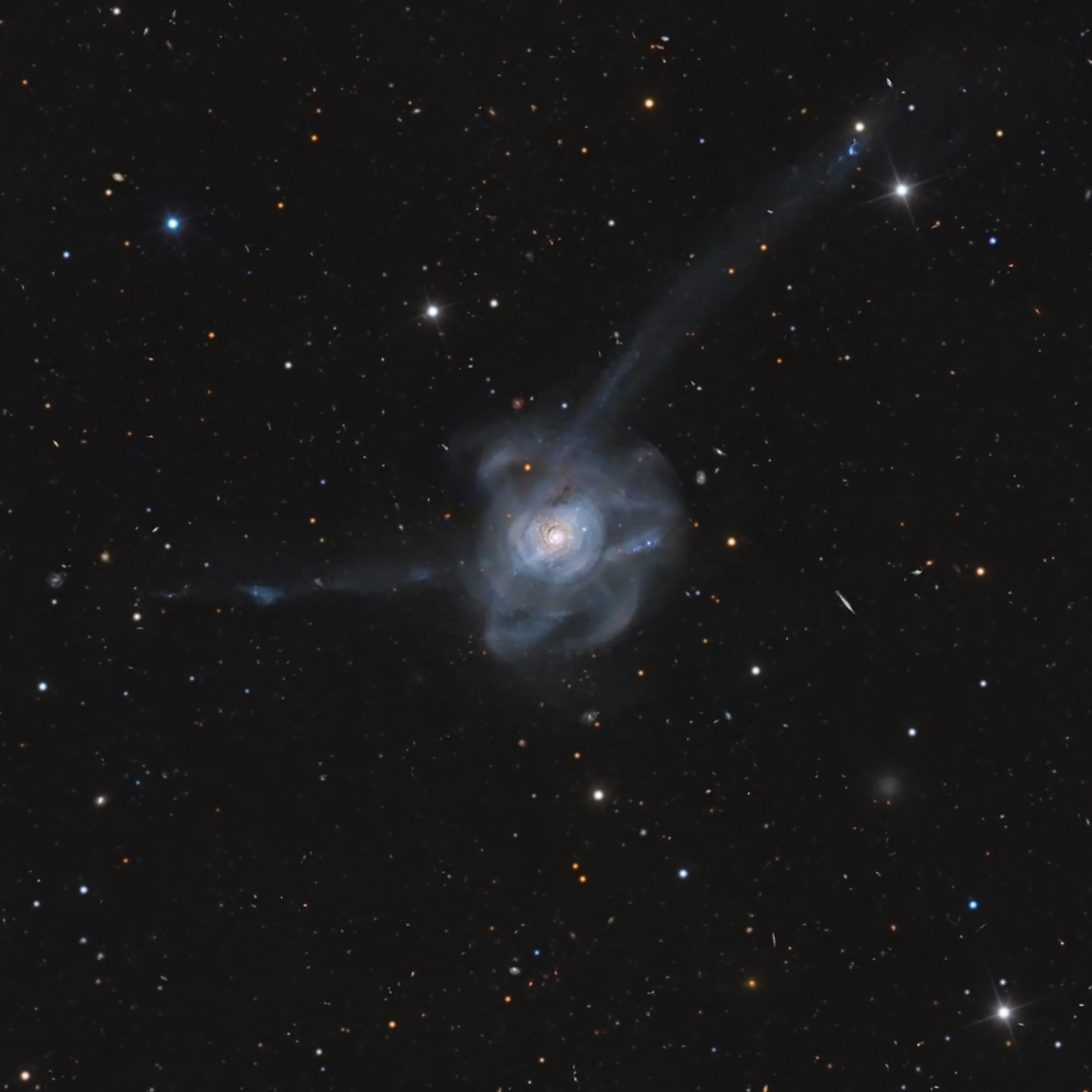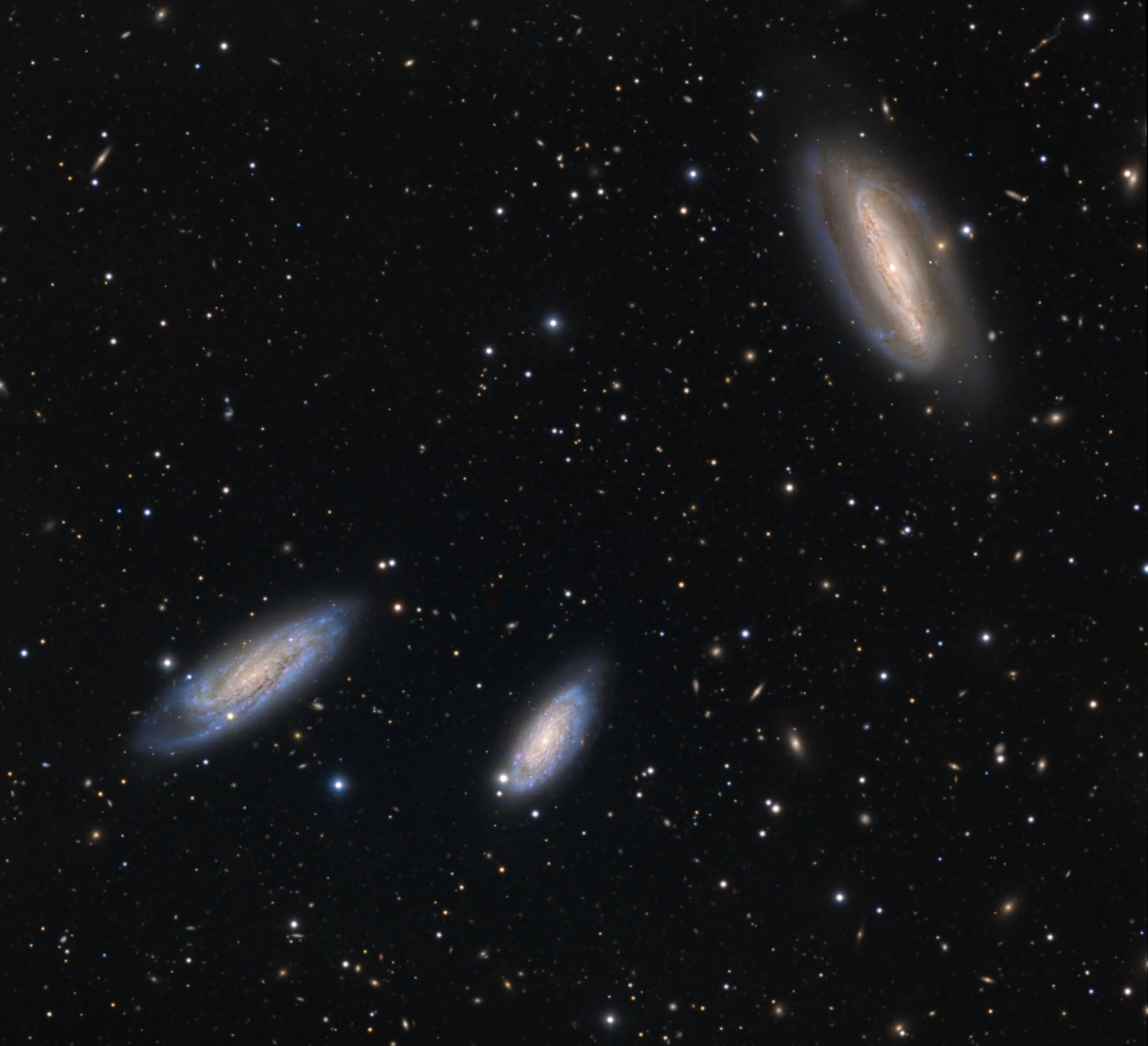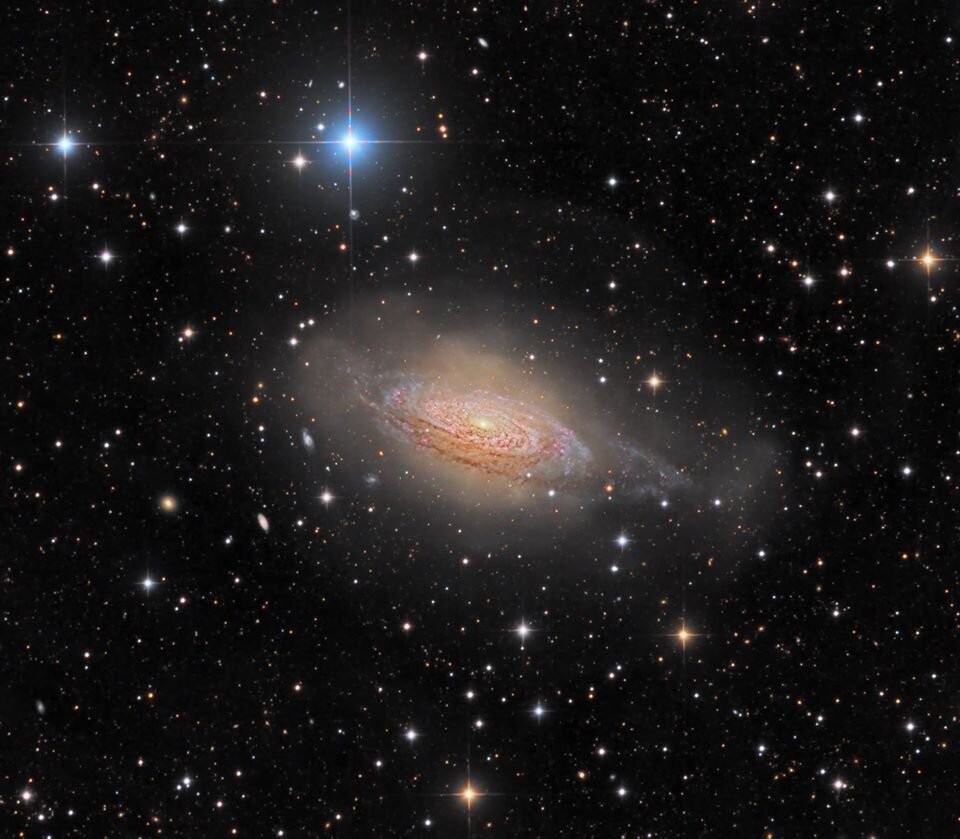
AAPOD2 Image Archives
WR 8 - Rarely imaged Wolf Rayet star in HOO with RGB stars
WR 8 is a rarely imaged Wolf-Rayet star located in the southern constellation of Puppis. Wolf-Rayet stars are massive, evolved stars that undergo intense stellar winds, shedding their outer layers and enriching the surrounding interstellar medium with heavy elements. WR 8 belongs to this rare class, characterized by high surface temperatures and strong emission lines, particularly in ionized hydrogen (Hα) and oxygen (OIII).
Captured from the dark skies of Observatorio El Sauce, Chile, this image combines narrowband HOO data with RGB stars to preserve the natural colors of the field. The nebula surrounding WR 8 is shaped by powerful stellar winds interacting with previous ejecta, creating a complex structure of ionized gas. These turbulent regions are key to understanding the life cycles of massive stars and their impact on galactic evolution. The detailed exposure reveals intricate filaments and expanding shells, emphasizing the dynamic processes occurring in this rarely studied system.
NGC 602
NGC 602 is a striking open cluster nestled within the Small Magellanic Cloud (SMC), a satellite galaxy of the Milky Way located some 200,000 light-years away. This vibrant cluster, surrounded by the emission nebula N90, is illuminated by young, massive stars that have recently formed within the dense clouds of gas and dust. The intense ultraviolet radiation from these hot stars sculpts and ionizes the surrounding material, creating a dynamic, glowing environment rich with cosmic activity.
There is what appears to be a faint planetary nebula, possibly identified as SMC-B Bru 2-165, nestled within this stellar nursery. Planetary nebulae represent the final stages in the life cycle of medium-sized stars, where the outer layers are ejected, leaving a hot, dense core.
The SMC itself offers a unique window into stellar evolution, given its low metallicity and proximity. Capturing such delicate and rare features in this image highlights the interplay of star formation, destruction, and the rich tapestry of phenomena present within this neighboring galaxy.
NGC 602
Nestled 200,000 light-years away in the Small Magellanic Cloud, the young star cluster NGC 602 lights up the surrounding nebula N90 with its brilliant and energetic stars. Among them is the exceptionally hot O3 star Sk 183, one of the brightest stars fueling this luminous star-forming region. The intense radiation from these massive blue stars carves out cavities in the nebula, shaping swirling regions of ionized gas and dust.
Curiously, a faint, small structure resembling a planetary nebula also appears nearby, possibly identified as SMC-B Bru 2-165. This could hint at earlier stellar generations in this vibrant region, where new stars are born within rich molecular clouds.
NGC 7252 Atoms For Peace Galaxy
NGC 7252 is a lenticular galaxy 220 million light years away in the constellation Aquarius.
The galaxy is nicknamed the “Atoms “for Peace galaxy because its stars form loop-like structure (tidal tails) that resemble a diagram of electrons orbiting an atomic nucleus. Similar to the logo used by the United States in the 1950’s to promote its Atoms for Peace campaign.
The galaxy is the result of a merger of two galaxies over a billion years ago.
NGC 5054 “Gem in Virgo”
NGC 5054 is a beautiful spiral galaxy in the Virgo constellation. The galaxy is small in the field of view at an apparent 4×2’. The galaxy has an irregular shape with two of the arms bending back around the galaxy. This small but relatively bright galaxy and allows a reasonable amount of detail and color to come through. This is amazing when you consider that the light from this galaxy has been travelling for 82 million years towards us. The dust lanes are quite evident, as are the star forming areas of the two major spiral arms. These are within the bluish regions of the arms. Its irregular shape suggests a possible interaction in the past.
The background is littered with hundreds of small galaxies. You can go to website to see wider version.
Imaged in LRGB on a Planewave CDK 1000 at El Sauce, Obstech, Chile
Integration Time: 28 hours
Copyright: Mark & Mike
NGC 2442
Image Description and Details :
NGC 2442 is located around 50 million light-years away in the constellation of Volans. The galaxy is 75,000 light-years wide and has quite an peculiar shape featuring two dusty spiral arms extending from a central bar that gives it a hook-like appearance. Given its appearance it is often referred to as “The Meat Hook Galaxy.” The galaxy’s distorted shape is most likely the result of a close encounter with a smaller galaxy some time in the past. A considerable amount of IFN is present in the field proximate to the galaxy and the image shows faint star streams at the ends of the arms of the galaxy.Imaged in LRGB and H alpha OTA CDK 1000 Luminance, RGB and H alpha. Additional RGB RiDK 500.Imaged at Observatorio El Sauce, ChileIntegration time: 47 hoursImage Processing: Mark Hanson and Mike Selby
Copyright: Mark Hanson_Mike Selby
NGC 7582 NGC 7590 NGC 7599
Image Description and Details :
NGC 7582, 7590 and 7599 are an interacting group of galaxies situated 70 million light years away in the constellation of Grus.
Studies in indicate the existence of faint H I bridges between the galaxies.
NGC 7582 at the top right is the brightest galaxy of this trio. It is of interest as it exhibits the characteristics of both a starburst and a Seyfert II spiral galaxy. The starburst activity is quite intense but is localized to several regions.
In 1996 a study indicated that NGC 7582 appears to have two rather than a single nuclei indicating a merger with another galaxy sometime in the distant past.
Imaged in LRGB on our CDK 1000 at El Sauce, Obstech, Chile
Image Processing: Mike Selby
System Control Software : Voyager by Leo Orazi
Integration Time: L 16 hours 900s exp RGB 4 hours each 900s
Copyright: Mike Selby
M83
M83 is a barred spiral galaxy located 15.21 million light years from Earth in the southern constellation Hydra. With a diameter of about 55,000 light years, it is roughly half the size of the Milky Way. M83 is one of the nearest and brightest barred spirals in the sky.
One interesting feature of M83 is the high number of supernova's observed during the last century.
Newer generations of stars in M83 form mainly in clusters on the edges of the dark, spiraling dust lanes. These bright, young stellar groupings are only a few million years old and produce massive amounts of ultraviolet light. That light is absorbed by the surrounding diffuse gas clouds, causing them to glow in pinkish hydrogen light.
Imaged in LRGB and H alpha on our CDK 1000 at El Sauce (Obstech) in the Atacama Desert in Chile.
Image Processing: Roberto Colombari and Mike Selby
System control: Voyager by Leonardo Orazi
COPYRIGHT: [Mike Shelby][1]
RCW 60
Image Description and Details :
RCW 60 is a rarely imaged nebula. Part of the Lambda Centaurus nebula complex (centered around RCW 62). This is actually 2 distinct nebulae at different distances: Gum 39 and Gum 40. RCW 60 is located around 13000 light years from Earth.Imaged in Narrow Band Hubble Palette SHO on our Officina Stellare RiDK 400 telescope at El Sauce (Obstech) in the Atacama Desert in Chile.
Ha, OIII, S2 13 hours each, 1200s exp. RGB stars 20x60s exp each channel.
Copyright Information: Mike Selby Image Processing: Mike Selby System controlled by Voyager from Leonardo OraziChile Team: Mike Selby , Stefan Schmidt, Leo Orazi, John Kasianowicz, Scott Johnson, Josh Balsam, Rick Stevenson
NGC 3521
NGC 3521 often termed the Bubble Galaxy is a flocculent intermediate spiral galaxy located around 35 million light-years away from Earth in the constellation Leo. It is a spiral galaxy with a trace of a bar structure , a weak inner ring , and moderate to loosely wound arm structure. The galaxy spans 50,000 light years which is approximately half that of our galaxy the Milky Way.
Imaged in LRGB H alpha on my Officina Stellare RiDK 500 telescope at El Sauce (Obstech) Atacama Desert, Chile.
15 hours Luminance, 11 hours Ha, 5 hours each RGB bin 2.
Copyright: Mike Selby



